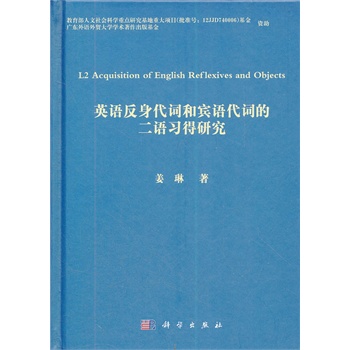
英語(yǔ)反身代詞和賓語(yǔ)代詞的二語(yǔ)習(xí)得研究
- 所屬分類:
英語(yǔ)學(xué)術(shù)著..
- 作者:
姜琳 著
- 出版社:
科學(xué)出版社
- ISBN:9787030340627
- 出版日期:2012-5-1
-
原價(jià):
¥42.00元
現(xiàn)價(jià):¥35.70元
-
本書(shū)信息由合作網(wǎng)站提供,請(qǐng)前往以下網(wǎng)站購(gòu)買: 京東商城
當(dāng)當(dāng)網(wǎng)
圖書(shū)簡(jiǎn)介
本書(shū)由姜琳著,介紹了英語(yǔ)代詞的二語(yǔ)習(xí)得研究,著重比較了中國(guó)英語(yǔ)學(xué)習(xí)者在反身代詞以及賓語(yǔ)代詞兩個(gè)領(lǐng)域的習(xí)得情況。
實(shí)驗(yàn)結(jié)果表明,被試對(duì)英語(yǔ)反身代詞局部約束性的掌握遠(yuǎn)好于對(duì)賓語(yǔ)代詞有形性的掌握。漢語(yǔ)和英語(yǔ)在這兩個(gè)領(lǐng)域都存在差異,為什么他們可以很好地掌握前者,而很難掌握后者呢?針對(duì)這種不對(duì)稱現(xiàn)象,本書(shū)將從“基于普遍語(yǔ)法的語(yǔ)言習(xí)得理論”(UG-base(1
Approach)和“基于使用的語(yǔ)言習(xí)得理論”(Usage-based
Approach)兩個(gè)角度對(duì)實(shí)驗(yàn)結(jié)果進(jìn)行全面分析,討論三種可能的原因。
目錄
本書(shū)由姜琳著,介紹了英語(yǔ)代詞的二語(yǔ)習(xí)得研究,著重比較了中國(guó)英語(yǔ)學(xué)習(xí)者在反身代詞以及賓語(yǔ)代詞兩個(gè)領(lǐng)域的習(xí)得情況。 實(shí)驗(yàn)結(jié)果表明,被試對(duì)英語(yǔ)反身代詞局部約束性的掌握遠(yuǎn)好于對(duì)賓語(yǔ)代詞有形性的掌握。漢語(yǔ)和英語(yǔ)在這兩個(gè)領(lǐng)域都存在差異,為什么他們可以很好地掌握前者,而很難掌握后者呢?針對(duì)這種不對(duì)稱現(xiàn)象,本書(shū)將從“基于普遍語(yǔ)法的語(yǔ)言習(xí)得理論”(UG-base(1 Approach)和“基于使用的語(yǔ)言習(xí)得理論”(Usage-based Approach)兩個(gè)角度對(duì)實(shí)驗(yàn)結(jié)果進(jìn)行全面分析,討論三種可能的原因。
Acknowledgements
前言
Abstract
Chapter I Univeal Grammar and Second Language Acquisition
1.1 Introduction
1.2 UG and SLA
1.2.1 Principles and Paramete of UG
1.2.2 SLA
1.2.2.1 The Binding of Reflexives
1.2.2.2 The Liceing of Null Objects
1.2.3 Three Major UG-based SLA Theories
1.2.3.1 The Full Trafer Full Access Hypothesis
1.2.3.2 The Minimal Trees Hypothesis
1.2.3.3 The Failed Functional Features Hypothesis
1.3 Summary
Chapter 2 Cross-Linguistic Variation on the Binding of Reflexives
and Liceing of Null Objects
2.1 Introduction
2.2 Cross-linguistic Variation on the Binding of Reflexives
2.2.1 The Parameterized Approach
2.2.2 The Move-to-Infl Approach
2.2.3 The Relativized SUBJECT Approach
2.2.4 A New Approach to the Cross-linguistic Variation on the
Binding of Reflexives
2.3 Cross-linguistic Variation on the Liceing of Null
Objects
2.4 The Binding of Reflexives and the Liceing of Null
Objects.
2.5 Summary
Chapter 3 Studies on the Acquisition of Reflexive Binding and Null
Objects
3.1 Introduction
3.2 Reflexive Binding in L1 Acquisition
3.3 Reflexive Binding in L2 Acquisition
3.3.1 Hirakawa (1990)
3.3.2 Yuan (1994)
3.3.3 MacLaughlin (1998)
3.3.4 Thomas (1995)
3.3.5 Jiang (2009b)
3.3.6 White et al. (1997)
3.4 Null Objects in L1 Acquisition
3.5 Null Objects in L2 Acquisition
3.5.1 Yuan (1997)
3.5.2 Park (2004)
3.6 Summary
Chapter 4 Main Study
4.1 Introduction
4.2 The Study
4.2.1 Subjects
4.2.2 Materials and Procedure
4.3 Results
4.3.1 Reflexive Binding
4.3.1.1 Group Results
4.3.1.2 Individual Results
4.3.1.3 Summary
4.3.2 Null Objects
4.3.2.1 Group Results
4.3.2.2 Individual Results
4.3.2.3 Summary
4.3.3 Correlation between Reflexive Binding and Null
Objects
4.4 Summary
Chapter 5 Discussion
5.1 Introduction
5.2 A-Binding/A'-Binding Asymmetry
5.2.1 Native Language Trafer in L2 Acquisition
5.2.2 Learning Strategies in L2 Acquisition
5.2.3 A New Approach Involving an Interaction of the L1 Grammar
and the L2 Input
5.2.3.1 Morphological Complexity of the English Reflexive
5.2.3.2 Binding to Non-Subjects
5.2.3.3 Overt Agreement Morphology
5.2.4 The Implicatio of the Findings for UG-based SLA
Theories
5.3 The Finite/Non-finite Asymmetry in the A-Binding Domain
5.4 The A-bound/A'-bound Null Object Asymmetry in the A'-binding
Domain
5.5 Conclusion
References
Appendix Ⅰ The Main Test
Appendix Ⅱ The Proficiency Test

